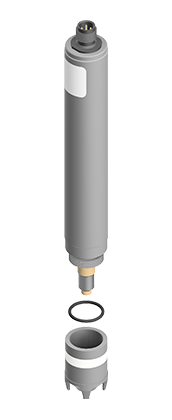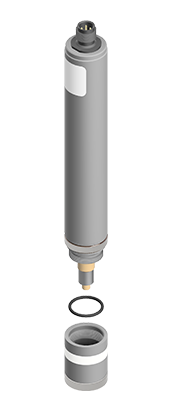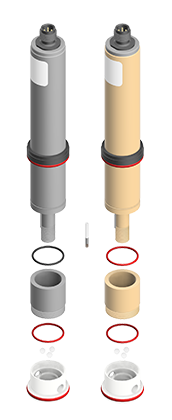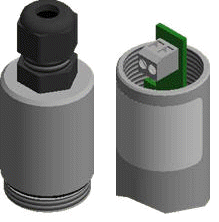Produktinformation
Sensoren
Unsere Sensoren haben ihre Einsatzbereiche im VE-Wasser, Trinkwasser, Schwimmbadwasser, Brauchwasser, Kühlwasser, CIP-Anlagen, Abwasser, etc.
Die höchste Auflösung liegt bei 1 µg/L, der größte Messbereich bei 10.000 ppm. Ein speziell auf die Messzellen abgestimmtes Mess- und Regelgerät schöpft deren Vorteile voll aus. Natürlich können die Messzellen aufgrund verschiedener elektrischer Ausführungen, z.B. über den 4-20 mA-Anschluss oder auch über kundenspezifische Anschlüsse an kundenseitige Mess- u. Regelgeräte angeschlossen werden.
Es können folgende Entkeimungsmittel gemessen werden:
Brom, Chlor, Chlordioxid, Chlorit, Ozon, Peressigsäure, Wasserstoffperoxid.
Die Sensorenfertigung unterliegt strengsten Qualitätskontrollen, d.h. während der Fertigung werden die Einzelkomponenten laufend kontrolliert. Die fertigen Sensoren werden in einem Testwasserkreislauf für mehrere Stunden einer Endkontrolle unterzogen. Die Messdaten werden aufgezeichnet und protokolliert.
Hier können Sie sich unseren aktuellen Flyer herunterladen.
Bitte beachten Sie hierzu auch unsere Unternehmensleitlinien.
Marken

TARAeasy
TARAeasy
CCF1: Freies Chlor, pH-abhängig

TARAbase
TARAbase
TARAbase umfasst alle membranbedeckten 2-Elektrodensysteme, die mit der Membrankappe des Typs M20 arbeiten.
Verfügbar sind folgenden Ausführungen:
CL4: Freies Chlor, pH-abhängig
CL2: Freies Chlor, pH-abhängig
CD4: Chlordioxid
OZ1: Ozon

TARAline
TARAline
Verfügbar sind folgenden Ausführungen:
CS4: Freies Chlor, reduzierte pH-Abhängigkeit
CC1: Chlor auf Cyanursäurebasis, reduzierte pH-Abhängigkeit
CP4.0: Gesamtchlor, reduzierte pH-Abhängigkeit
BR1: Freies Brom bzw. 1-Brom-3-chlor-5,5-dimethyl-hydantoin
MST1: Chlorit

TARAtec
TARAtec
TARAtec series „10“: mechanisch strapazierfähige Membrane und verbesserte Tensidbeständigkeit
TARAtec series „9“: vereinigt die Vorteile der 10er Serie mit einem erhöhten Temperatureinsatzbereich bis max. 60 °C
CD10: Chlordioxid
OZ10: Ozon
P10: Peressigsäure
P9: Peressigsäure, Messwassertemperatur max. 60 °C
WP10: Wasserstoffperoxid
CH10: Chlor

TARAsens
TARAsens
AS2: Freies Chlor / Chlordioxid bis 50°C
AS3: Freies Chlor / Chlordioxid bis 70°C
Technologien
Membranbedeckt
Die Sensoren haben einen Durchmesser von 25 mm und eine Länge von 175 mm mit Schraubsteckanschluss, bzw. 220 mm in der 4 – 20 mA-Ausführung.
Es werden verschiedene elektrochemische Messverfahren eingesetzt:
2-Elektrodensystem
Bei diesem System ist die Messelektrode aus Gold, die gemeinsame Gegen- und Bezugselektrode aus Silber mit einem Silberhalogenidüberzug. Zwischen beiden Elektroden ist eine Vorspannung (Polarisationsspannung) angelegt.
3-Elektrodensystem
Bei dem potentiostatischen System ist die Messelektrode aus Gold, die Bezugselektrode aus Silber mit einem Silberhalogenidüberzug und die Gegenelektrode aus Edelstahl. Durch den Potentiostaten wird die Messelektrode auf einem geeigneten Arbeitspotential gehalten.
Vorteile des membranbedeckten Sensors
- Die Handhabung, Inbetriebnahme und Wartung ist einfach. Das Elektrodensystem ist sehr lange haltbar. Verschleißteile sind der Elektrolyt und die Membrankappe. Die Membrankappe muss etwa jährlich erneuert werden.
Damit sind die Wartungskosten niedrig. - Die Einlaufzeit der meisten Sensortypen beträgt weniger als 1 Stunde.
- Es ist kein Nullpunktabgleich erforderlich, so dass kein „Nullwasser“ benötigt wird.
Dadurch ist der Kalibrieraufwand aufgrund des Einpunktabgleiches (nur Steilheitsabgleich erforderlich) gering. - Die Anströmabhängigkeit ist gering. Veränderungen der Anströmung haben nur geringe Auswirkung auf das Messsignal.
- Ein besonderer Vorteil ist der Betrieb der Sensoren unter Druck bis ca. 1 bar (auf Anfrage auch höher), wodurch eine einfache Messwasserrückführung ermöglicht wird.
- Die Temperaturkompensation ist in jeder Sensor integriert.
- Die Ansprechzeit, bis zum Erreichen von 90 % des Endwertes, ist bei fast allen Messzellentypen kleiner 2 Minuten.
- Die Langzeitstabilität ist sehr gut. Der Steilheitsverlust beträgt ca. 1 % pro Monat.
- Durch das niederohmige Messsignal sind längere Messleitungen möglich.
- Die Sensoren gibt es mit verschiedenen Messbereichen und elektrischen Anschlüssen, so dass eine Anpassung an kundenseitig vorhandene Mess- und Regelgeräte möglich ist. Kundenspezifische Ausführungen sind möglich.
- Zur Überprüfung können die Sensoren ohne Aufwand ausgebaut und zurückgeschickt werden.
Nicht membranbedeckt
Die Sensoren TARAsens AS2 und TARAsens AS3
Die Legionellen-Bekämpfung und der Biofilmabbau in Warmwasserleitungen bzw. Warmwasser-Boilern (natürlich auch in Kaltwasserleitungen) wird seit einiger Zeit immer wichtiger. Man findet diese immer stärker werdende Verkeimungsproblematik vor allem in Gebäuden und Institutionen mit zentraler Wasserversorgung wie Krankenhäuser, größeren Hotels, Schulen, Kasernen usw.
Um einwandfreie hygienische Bedingungen zu erreichen, kann wahlweise Chlor oder Chlordioxid eingesetzt werden. Die bisherigen Messsysteme zum Messen der Keimtötungsmittelkonzentration können nur drucklos betrieben werden. Das heißt, das Messwasser ist verloren, in der Regel ca. 30L/h. Dieser permanente (Warm-) Wasserverlust verursacht unnötig hohe Kosten. Das Ausgasen des (drucklosen) Messwassers führt eventuell auch zu Messproblemen.
Somit war der Bedarf gegeben einen neuen Sensor speziell für den Einsatz in der Trinkwasserentkeimung zu entwickeln. Dieser Sensor TARAsens AS2 ist bis mindestens 50 °C (TARAsens AS3 max. 70 °C) und 8 bar Druck einsetzbar.
Sinnvollerweise werden die TARAsens AS-Sensoren im Bypass zur Hauptwasserleitung mit eigener Messwasserumwälzung eingesetzt. Der Bypass ermöglicht es, den Sensor im Bedarfsfall einer Wartung zuzuführen, ohne den gesamten Wasserfluss unterbrechen zu müssen.
Die Sensoren stehen als TARAsens AS…-CL für die Chlormessung und als TARAsens AS…-CD für die Chlordioxidmessung zur Verfügung. Aufgrund der unterschiedlichen Empfindlichkeit ist es wichtig, dass das Messgerät einen weiten Steilheitsabgleichbereich hat. Somit kommen nur mikroprozessorgesteuerte Messgeräte bzw. Regler in Frage. Ein Nullpunktabgleich ist nicht erforderlich.
Signalausgänge
0 … -2000 mV
0 … +2000 mV
4-20 mA
Modbus RTU
Elektrische Anschlüsse
Signalausgang Analog
0 … +/-2000 mV

5-poliger M12-Steckverbinder
(Analoge oder digitale interne Signalverarbeitung)
4-20 mA (unkalibriert)

2-polige Anschlussklemme
(Analoge interne Signalverarbeitung)

5-poliger M12-Steckverbinder
(Analoge interne Signalverarbeitung)
Signalausgang digital
Modbus RTU

5-poliger M12-Steckverbinder
(Digitale interne Signalverarbeitung)
Sensorauswahl
Was wollen Sie messen?

Hier können Sie sich die komplette Übersicht der Sensorauswahl herunterladen.
